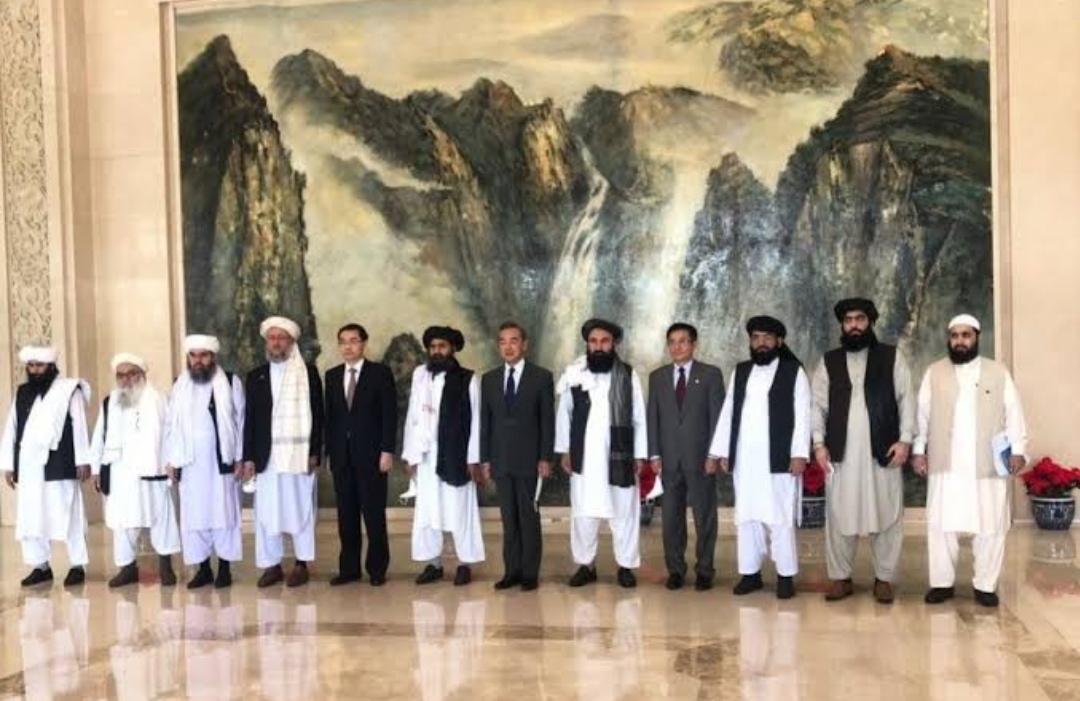China May Fall Into A Huge Financial Trap In Afghanistan

Chinese foreign minister Wang Yi with Taliban terror group leader in Beijing
Starting 2013, China started getting involved abroad on its BRI initiative. However building roads, dams and power plants require huge expenditures and soon China found itself being forced into spending billion of dollars. It is estimated that two main Chinese banks — the China Development Bank and the Export-Import Bank of China, have together lent an estimated $282 billion to countries throughout Asia, Africa, Latin America and Europe.
No wonder, in 2020, China’s capital account recorded a deficit for the first time. Two countries,Pakistan and Afghanistan, have been the biggest beneficiary of Beijing’s overseas infrastructure drive. The so-called China Pakistan Economic Corridor alone is reportedly worth $90 billion. Pakistan is trying to become a key link between China’s interests in Central Asia and the shipping lanes in the Indian Ocean.
However China realized that CPEC passes through Indian territory presently under illegal occupation of Pakistan. Therefore it tried to cow down India in Ladhak. However after Galwan the tide has turned against China. Now India is in a position to carry out an offensive into Tibet and liberate it at least partially for the Tibetan Go argument in Exile to shift there. Alternatively India may mount an offensive to liberate Gilgit Baltistan. They are legitimately Indian territory. However with Indian Victory, the entire Chinese initiative for Central Asia will go for a toss. China will lose billions of dollars.
The above loss will lead to domestic turmoil as any failure of BRI will lead to economic downturn. The Chinese people may not be all that ready to follow the Chinese Communist Party blindly if there are no economic benefits. Beijing’s largesse abroad will then be questioned even within the Party. Indeed, the Chinese banks were set up to provide fiscal stimulus and business loans at home. Instead these banks have been funding Pakistan and now Taliban. China Development Bank is already under-capitalized compared to its global peers. Now they are getting mired in distressed nations. Even with Beijing’s help, Pakistan is a basket case. It has taken 13 bailouts in 30 years from the International Monetary Fund.
The sudden panic in otherwise planned withdrawal of the U.S. from Afghanistan — the 1975 fall of Saigon déjà vu — has been heralded as a win for China by some. Beijing thinks that it has been given an opportunity to extend its influence across the region. Chinese CPC tabloid has even warned Taiwan not to rely on American protection. The U.S.’s hurried exit from Afghanistan was certainly bad publicity, but America’s debacle is not a win for China.
However, China may soon realize that it was better to have American troops in Afghanistan. Soon Afghanistan is going to become a big headache for Beijing, as chaos there will spill over not just to Pakistan but even to Chinese restive region of Xinjiang. The People’s Republic has invested huge infrastructure projects as well as extended huge loans to Islamabad as part of the Belt and Road Initiative, one of President Xi Jinping’s signature policies. All are going to be doomed.
Beijing says that the Afghan Taliban are “a pivotal military and political force,” but sees the Pakistani Taliban as a terrorist group. In late July, during an Afghan Taliban diplomatic charm offensive visit, Beijing managed to extract a public pledge that the group would not allow fighters to use Afghan soil as a base to attack China. However Pakistan last week placed blame on the Taliban across the border for the Dasu bus attack, saying, “Afghan soil was used for this incident.” This attack followed another incident in April, when the Pakistani Taliban carried out a suicide bombing at a hotel where the Chinese ambassador was staying.
Thus China is quite uneasy with Afghanistan’s new rulers. While China has not invested much in Afghanistan, it can’t afford it to destabilize Pakistan. How can Beijing forget its last creditor’s trap, in Venezuela six years ago. One more failed bet on a failed state will cut to the heart of Xi’s BRI dreams.
Venezuela had been Chinese banks’ favourite destination. With loan-for-oil deals, China thought that the country’s petroleum production was enough collateral for debt repayments. By the beginning of President Nicolás Maduro’s 2013 term, China had provided Venezuela with a $40 billion credit line, with about $30 billion of that amount still outstanding.
That was a miscalculation. During the 2014 to 2015 commodities downturn, Brent crude went from $100 per barrel to half that; and China had to renew $9 billion of previous loan tranches just to help the Venezuelans navigate through the crisis and boost oil production capacity. China still hasn’t got a big chunk of its money back. Last year, the Venezuelan government reportedly received a grace period on loans worth some $19 billion.
That creditor trap has dented confidence. China’s policy banks have not delivered fresh funding to Venezuela since 2013. On top of that, their total development loans abroad peaked in 2016, shortly after the debt extensions in Venezuela. Failure to protect its interests in Pakistan will raise even more questions about Xi’s nation-building model.
Much of Beijing’s troubles comes from the way it approaches loan-making. Where the World Bank funds projects based on concrete metrics such as country risk premium and required rate of return, China seems to operate on instinct. Instead of looking backward into a country’s credit history, Beijing tries to project what the debtor might look like if it got enough investment and infrastructure — a pie-in-the-sky approach.




